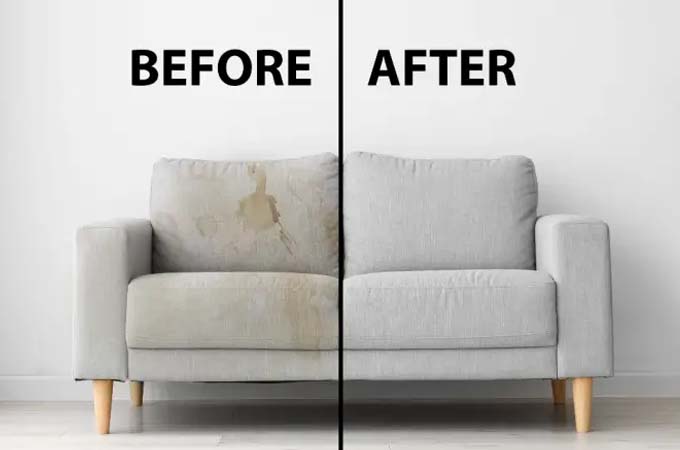Table of Contents
Introduction:
Upholstered furniture adds comfort and style to your home, but it can also be a magnet for dirt, stains, and allergens. Regular cleaning is essential to maintain the appearance and longevity of your furniture, especially in Australia, where dust, humidity, and outdoor activities can all contribute to wear and tear. This guide provides practical Upholstery Cleaning tips for keeping your upholstery looking new and feeling fresh.

How to Remove Common Stains from Upholstery
Stains are inevitable on upholstered furniture, but prompt action can prevent them from becoming permanent:
- Blot, Don’t Rub: When a spill occurs, gently blot the area with a clean, absorbent cloth to soak up as much liquid as possible. Avoid rubbing, as this can spread the stain and damage the fabric.
- Water-Based Stains: For stains like coffee, juice, or food, mix a small amount of dish soap with water. Dip a cloth into the solution and blot the stain, working from the outside in to prevent spreading.
- Oil-Based Stains: For grease or oil stains, sprinkle baking soda or cornstarch on the area to absorb the oil. Let it sit for 15 minutes before vacuuming it up. Follow with a mild detergent solution if needed.
- Ink Stains: Dab the stain with a cloth soaked in rubbing alcohol, taking care not to oversaturate the fabric. Blot until the ink is lifted, then rinse with a damp cloth.
- Pet Stains: Use a mixture of water and vinegar to neutralize odors and clean the area. For stubborn stains, consider an enzyme cleaner specifically designed for pet messes. By treating stains quickly and using the right methods, you can keep your upholstery looking its best.
[lead-form form-id=1 title=Fill to Get Free Cleaning Checklist]
The Importance of Regular Vacuuming
Regular vacuuming is one of the simplest yet most effective ways to maintain your upholstered furniture:
- Weekly Routine: Vacuum your upholstery weekly to remove dust, dirt, and allergens that can become embedded in the fabric. Use a vacuum with an upholstery attachment for best results.
- Focus on High-Traffic Areas: Pay extra attention to areas that see the most use, such as armrests, seat cushions, and the backs of sofas and chairs.
- Lift and Rotate Cushions: Lift and vacuum under cushions, and rotate them regularly to ensure even wear and prevent permanent indentations.
- Vacuum Before Cleaning: Always vacuum your upholstery before applying any cleaning solutions to remove loose dirt that could interfere with the cleaning process. Regular vacuuming helps prevent the buildup of dirt and extends the life of your upholstery.
Spot Upholstery Cleaning Tips for Immediate Results
Spot cleaning is essential for maintaining the appearance of your upholstery between deep cleanings:
- Test in an Inconspicuous Area: Before using any cleaning solution, test it on a hidden area of the fabric to ensure it doesn’t cause discoloration or damage.
- Use the Right Cleaner: Choose a cleaner appropriate for your fabric type—whether it’s water-based, solvent-based, or a specialized upholstery cleaner.
- Blot Gently: Apply the cleaner to a cloth and blot the stain gently. Avoid using too much liquid, as it can saturate the fabric and create watermarks.
- Rinse and Dry: After removing the stain, blot the area with a cloth dampened with clean water to remove any residue. Allow the area to air dry completely. By spot cleaning as soon as spills occur, you can prevent stains from setting and keep your furniture looking fresh.
You may also like to read about-“Upholstery Cleaning Services: A Comprehensive Guide”
Using Natural Solutions for Safe Cleaning
Natural cleaning solutions are a safe and effective option for those who prefer to avoid harsh chemicals:
- Vinegar and Water: A solution of equal parts white vinegar and water can effectively clean many types of upholstery. It’s especially useful for neutralizing odors and removing light stains.
- Baking Soda: Sprinkle baking soda on your upholstery, let it sit for 15 minutes, then vacuum it up to remove odors and freshen the fabric.
- Essential Oils: Add a few drops of your favorite essential oil to your vinegar and water solution for a pleasant scent that lingers after cleaning.
- Castile Soap: For a gentle yet effective cleaner, mix a small amount of castile soap with water and use it to clean upholstered furniture. These natural solutions are not only effective but also environmentally friendly and safe for your family and pets.

How to Protect Your Upholstery from Spills
Preventing spills from becoming stains is key to keeping your upholstery looking new:
- Use Slipcovers: Consider using slipcovers or throws on heavily used furniture to protect the fabric from spills and stains. These can be easily removed and washed as needed.
- Apply Fabric Protector: Treat your upholstery with a fabric protector spray to create a barrier against liquids and stains. Reapply the protector every few months for continued protection.
- Set House Rules: Encourage eating and drinking in designated areas to reduce the risk of spills on your upholstered furniture.
- Keep Cleaning Supplies Handy: Store a small cleaning kit nearby with essential items like a spray bottle of water, a clean cloth, and a mild detergent. Quick access can make all the difference in treating spills promptly. Taking these preventive measures can help maintain the appearance and longevity of your upholstery.
You may also like to read about-“What is the Best Carpet and Upholstery Cleaner”
Maintaining Upholstery in Australia’s Climate
Australia’s climate, with its extremes of heat, humidity, and dust, can take a toll on your upholstery. Here’s how to protect your furniture:
- Humidity Control: Use a dehumidifier in areas with high humidity to prevent mold and mildew growth on your upholstery.
- Sun Protection: Keep your furniture out of direct sunlight to avoid fading and deterioration of the fabric. Use curtains, blinds, or UV-blocking window films to protect your furniture from sun damage.
- Dust Management: Regularly dust and vacuum your home to reduce the amount of dust that settles on your upholstered furniture, especially if you live in a dry, dusty area.
- Ventilation: Ensure proper ventilation in your home to reduce the risk of mold and mildew, particularly in humid or coastal regions. By adapting your care routine to Australia’s unique climate conditions, you can prolong the life and appearance of your upholstery.
you may also read about – “Why Professional Upholstery Cleaning is Essential in Australia“
Choosing the Right Cleaning Products for Your Fabrics
Not all upholstery fabrics are the same, and choosing the right cleaning products is essential for effective and safe cleaning:
- Read the Care Label: Always check the care label on your furniture for specific cleaning instructions and recommended products.
- Water-Based Cleaners: Use water-based cleaners for fabrics labeled “W” or “WS,” which can handle water-based cleaning solutions.
- Solvent-Based Cleaners: For fabrics labeled “S,” opt for solvent-based cleaners designed for dry cleaning. These are ideal for delicate or non-water-tolerant fabrics.
- Enzyme Cleaners: Enzyme-based cleaners are effective for organic stains, such as food or pet accidents, breaking down the stain at the molecular level. Choosing the right cleaner for your fabric type ensures effective cleaning without damaging the material.

Tips for Keeping Your Upholstery Looking New
Keeping your upholstery looking new requires consistent care and a few smart strategies:
- Regular Fluffing: Fluff cushions regularly to maintain their shape and prevent sagging. Rotate them periodically to ensure even wear.
- Avoid Sharp Objects: Keep pets’ nails trimmed and avoid placing sharp objects like keys or pens on the furniture to prevent tears and punctures.
- Professional Cleaning: Schedule a professional upholstery cleaning every 12-18 months to deep clean and refresh your furniture, especially if it’s heavily used.
- Limit Sun Exposure: As mentioned earlier, keep your furniture out of direct sunlight to prevent fading and deterioration.
- Vacuum Frequently: Regular vacuuming is essential for removing dust and allergens that can accumulate and dull the fabric’s appearance over time. By following these tips, you can keep your upholstery looking and feeling fresh for years to come.
Conclusion:
Maintaining the beauty and longevity of your upholstered furniture doesn’t have to be a daunting task. With regular care, prompt attention to stains, and the right cleaning products, you can keep your upholstery looking new and inviting. Whether you prefer natural cleaning solutions or need to adapt your routine to Australia’s unique climate, these tips will help you protect your investment and enjoy the comfort of your furniture for years to come.







